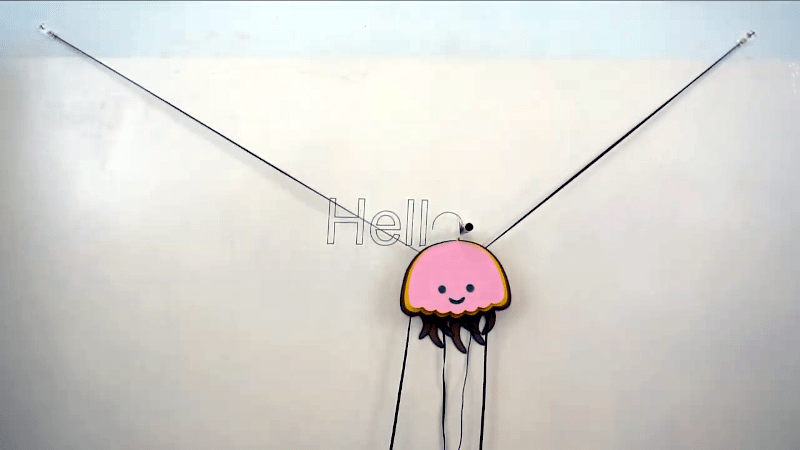If you’ve ever wanted to build a large format plotter but didn’t have the floor space, maybe put it up against the wall and make it cute. That’s the idea behind Fumik, the wall-drawing robot. As you might expect, the little device is just a motion base with a pen. We hope there’s paper against the wall since not everyone wants computer-generated art on their drywall.
The maximum size is apparently 5 m wide by 3 m tall, plenty of room to express yourself. The controller is an Arduino Mega, and stepper motors with a CNC shield drive the whole assembly. Interestingly, the motor and electronics are all onboard the jellyfish itself, rather than the wall.
The device only holds one pen at a time, but you can draw with one color and then manually change the pen. The files on GitHub are good, but you’ll need to intuit some of the mechanics from the videos. However, since it uses off-the-shelf hardware, it should be pretty easy to figure it out. This looks like a cheap and cheerful wall plotter, and the results speak for themselves.
We have seen similar wall plotters. More than once, even.
















I am surprized how precize this is (from the video). With the stepper motors so far apart, this is not a triangle (with the length determined solely by the length of the 3 sides, the upper being always the same) but a nonstable 4-sided mechanism. The pen being above this line even exaggerates this. I would expect a large weight with a long tail to make things more stable but apparently this is not needed! Nice work!
Looking at the video of the one with the crossed strings, and seeing how much it wobbles (there’s nothing to stop it from wobbling besides gravity) it actually makes more sense to run the motors as far apart as possible. Yeah, I could see the math getting harder, a lot harder, but the mechanics of it seems more stable.
Maybe that’s why they’re using Excel for the math. Using a timing belt(s) instead of string has to help too. But, “open source” ?? I can’t find much in the way of details. Maybe it’s in the Excel macro (space between the gears, etc.. Don’t know, maybe I’m missing a page/site somewhere.
I am intrigued though.
Reminds me of the upright CNC router Maslow https://hackaday.com/2016/10/14/maslow-brings-the-wall-plotter-into-the-woodshop/
Very similar, yeah. I’d like to extend this design by putting a plasma torch head in place of the printer and having a nearly arbitrarily large cnc cutter capable of 4mm thick steel, but other people have indicated that plasma cutters generally need to run flat rather than vertical to clear the molten debris. I’ve seen people using plasma cutters upright, though, so don’t know if I believe that. But it’s sure a neato low-footprint, low-cost design.
Actually we use plasma cutters for this size and bigger vertically often without issue. These torches pump gas at a high rate through the nozzle to help cool it and remove debris. The issue I can see is keeping a constant pressure on the metal vertically, the copper nozzle is also prone to melting if left in one place too long. The grain of the metal as well as being hot rolled or cold would make a big difference to the pressure and cutting speed needed to get decent results or to to not catch and melt the tip.
Compare to: https://github.com/snebragd/stringent
It seems Fumik hacker didn’t get the memo about the “Troublemaker Trapezoid” :D Ref. image:
https://hackster.imgix.net/uploads/attachments/507876/screen_shot_2018-06-22_at_22_57_04_TZ38wzNaHg.png?auto=compress%2Cformat&w=740&h=555&fit=max
With the trapezoid, more math is needed to figure out the pen position. Hopefully, they did that.
I made a pen plotter a while back. Someone on stack exchange did the math for the trapezoid kinematics. I implemented it in Java – I made a desktop program which takes SVGs and outputs g-code.
https://github.com/ademuri/iconograph-cnc/blob/main/client/src/com/ademuri/iconograph/Kinematics.java
Wouldn’t… the belts stretch with gravity, use?
I’d be curious how hard it would be to replace the pen with an ink jet printer head.. that would be a very interesting experiment
I believe Stuff Made Here did a similar thing on steroids
Not unless you use the lowest quality belts. Decent fiber-reinforced belts won’t stretch until the load gets unreasonably high, which it won’t here.
It reminded me of this! Glad someone took the effort to open source.
https://scribit.design/
Appreciating the cute factor here! Don’t seem to get a lot of that showcased
arduino mega for this is too much for 2 stepper motor and a servo. it would be better to see this with a arduino nano with the cnc header (doesn’t compile for only a 3% but if you remove some not useful code like serial prints it fits) o even the espduino and cnc header for wifi control since the sd interface for data transfer is tedious.